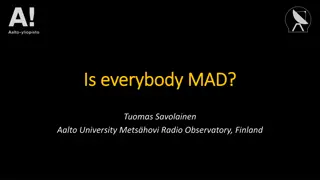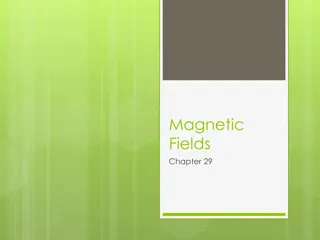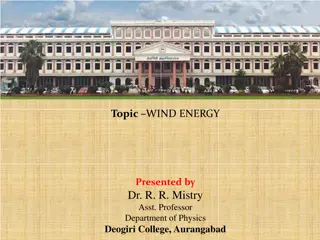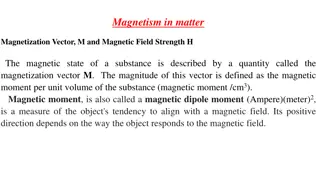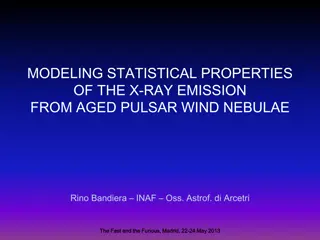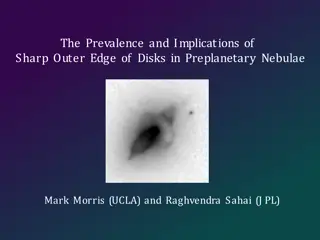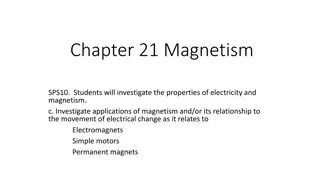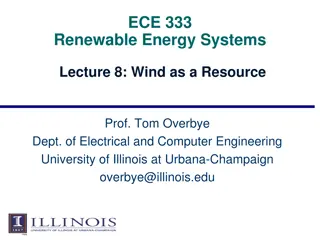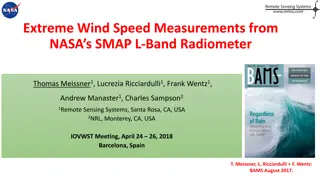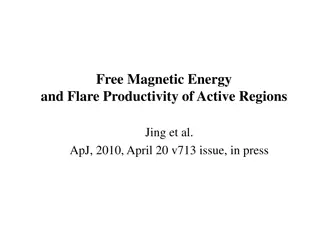Magnetic Fields in Supernova Remnants & Pulsar-Wind Nebulae
This content delves into the structures and dynamics of Supernova Remnants (SNR) and Pulsar-Wind Nebulae (PWNe), highlighting their interactions with magnetic fields, synchrotron sources, radiation properties, and evolutionary phases.
Download Presentation

Please find below an Image/Link to download the presentation.
The content on the website is provided AS IS for your information and personal use only. It may not be sold, licensed, or shared on other websites without obtaining consent from the author.If you encounter any issues during the download, it is possible that the publisher has removed the file from their server.
You are allowed to download the files provided on this website for personal or commercial use, subject to the condition that they are used lawfully. All files are the property of their respective owners.
The content on the website is provided AS IS for your information and personal use only. It may not be sold, licensed, or shared on other websites without obtaining consent from the author.
E N D
Presentation Transcript
Magnetic Fields in Supernova Remnants and Pulsar-Wind Nebulae 2013/12/18 Speaker : Yu-Hsun Cheng Professor: Yosuke Mizuno
Introduction Supernova remnants(SNR): This is the structure resulting from the explosion of a star in a supernova. It is formed by that the interactive between interstellar and that the expanding process of explosion of supernova. The shape: Cloud Shell ..etc. Solid SNR: Crab Supernova Shell SNR: Kepler supernova
Introduction Pulsar-Wind Nebulae(PWNe): A type nebula is formed by Pulsar-Wind. It often finds in SNR shell. Sometimes also find near old Pulsar star. But it s SNR has been vanished. Property: 1. The distance is closer the PWNe center, The brightness is higher. These is not general structure of SNR. 2. The radiation is high polarization, the radio spectrum is lower spectrum index ? = 0~0.3 3. An X-ray size that is generally smaller than their radio and optical size (due to smaller synchrotron lifetimes of the higher-energy electrons) 4. A photon index at TeV gamma-ray energies of ~2.3.
Introdution Pulsar wind nebulae can be powerful probes of a pulsar's interaction with its surroundings their properties can be used to infer the geometry, energetics, and composition of the pulsar wind, the space velocity of the pulsar itself, and the properties of the ambient medium Supernova remnants and pulsar-wind nebulae are prominent Galactic synchrotron sources at radio and X-ray wavelengths. The spectral analysis of the synchrotron emission can be used to deduce or constrain magnetic-field strengths and orientations.
Intrduction Galactic synchrotron sources is the object in our galaxy which emit non-thermal synchrotron radiation at radio or x-ray. If a SNR source is young and the emission is due to a pulsar. It is called pulsar-wind nebula(PWN). Thus a SNR may contain a PWN.
SNR dynamics SNRs evolve through various phases as their shock waves decelerate in the ambient medium. Very soon after an explosion deposits ~1051??? into the ISM, a shoch wave is driven into the surrounding ISM. Core-collapse SN eject several solar masses with a range of velocities 5000??? 1. Not long after the explosion, deceleration of the outer blast wave causes the formation of a reverse shock as inner ejecta are forced to decelerate. The begins the ejecta phase of evolution, characterized by the presence of both the forward shock heating ISM, and the reverse shock heating ejecta.
SNR Dynamics Cooling timescales are much longer than dynamical timescales, so this phase is essentially adiabatic. Depending on the density structure in the ejecta and surrounding material, the shock radius may evolve as ?0.6 ?0.9. Eventually the reverse shock moves in to the center of the SNR and , after what may be extensive reverberations, disappears.
Radio inferences Electrons emitting synchrotron radiation at radio wavelengths have energies of order 1-10 GeV . The observed radio power-law spectra ?? ? ?. Radio observations do not allow the separate deduction of energy in electrons and in magnetic field; the synchrotron emissivity of this power-law distribution of electrons if proportional to ?? For a spherical remnant of radius R pc at D kpc with ? = 0.5 : (?+1) 2 . 2 7?? 2/(???? 3) ? = 20 1 + ? ?9???? ?9?? ? ? ???? ??????? ?? 1 ??? ?? ?? ,? is the volume filling factor, k is the ratio of energy density in ions to that in electrons
Radio inferences SNRs are typically very inefficient synchrotron radiators, with a very small fraction of the 1051???. The thermal energies are very much larger than either particle of field energy. Thus equipartition magnetic-field strengths are feally just a measure of remnant surface brightness.
X-Ray and Gammer-Ray inferences Four Galactic SNRs show X-ray spectra dominated by synchrotron emission : G1.9+0.3,SN1006,G347.3- 0.5,G266.2-1.2. G1.9+0.3 and SN1006 are young. They are symmetric X-ray morphologies. The two source show thermal X-ray emission from fainter regions. SN1006 is widely accepted to be the remnant of a Type Ia supernova. G347.3-0.5 and G266.2-1.2 have much larger angular sizes and considerably more irregular morphologies.
X-Ray and Gammer-Ray inferences Power-law fits to the X-ray spectra are much steeper than radio spectra , indicating that the X- rays com from the cutting-off tail of the electron distribution. In standard DSA , the time for a particle to reach a relativistic energy E (from ?? ?) is given by ? ? ~ where ? 3 free path is proportional to the particle gyroradius ?? ? ?2 ????? is diffusion coefficient. The mean ? ??(E is relativistc energy)
X-Ray and Gammer-Ray inferences If we write ????= ???,? is the gyrofactor which is depending on the amplitude of scattering turbulence, then ? = 1 is Bohm diffusion and ? = const. ? > 1 is Bohm-like. Using quasi-liner theory ?(?) (?? amplitude of MHD turbulence resonant with particles of energy E.(So ? = ????? means a particular spectrum of turbulence) X-ray spectra as a diagnostic of magnetic fields is that high fields give short mean free paths , small diffusion coefficients, rapid acceleration, and higher maximum particle energies ?) 2where ?? is the
X-Ray and Gammer-Ray inferences A morphological argument is based on the commonly seen phenomenon of thin rims, in which synchrotron X-ray emission occurs at remnant peripheries in very narrow tangential features coincident with the shock location as inferred. Another argument for strong magnetic field is the discovery of variations in brightness on timescales of a few years of small features in X-ray synchrotron emission in Cas A and G347.3-0.5. Brightness increases on similar timescale are also observed.
X-Ray and Gammer-Ray inferences Very strong levels of magnetic turbulence also naturally predict these kinds of fluctuation without necessarily requiring quit as high values of ????. SN1006 show no such small features or brightness variation, perhaps as a result of a Type Ia origin with more-or-less uniform surrounding material. The absence of short-term variations does not imply absence of magnetic-field amplification; veryhigh B values could be generated in a quasi-steady state behind the shock, without producing short-term brightness fluctuations.
X-Ray and Gammer-Ray inferences The Fermi Gamma-Ray Space Telescope has been mapping the sky between about 0.2 and 300 GeV since its launch in 2008, with gradually improving statistics on any given region of sky. One important early result is the detection of Cas A between 0.5 and 50 GeV. The emission may be either leptonic, that is, electron bremsstrahlung plus inverse-Compton upscattering of local photon fields, or hadronic, from the decay into photons of ?0mesons produced in inelastic collisions between cosmic-ray protons and local thermal gas.
X-Ray and Gammer-Ray inferences The leptonic model shown in Fig assumes a mean density of 26 cm 1, which requires a mean magnetic field (averaged over the en- tire emitting region of Cas A) of about 0.12 mG. If the actual emission is hadronic, the IC contribution must be lower (fewer relativistic electrons), demanding a larger magnetic field to produce the observed synchrotron fluxes at radio energies. Similarly, any TeV detection or upper limit places lower limits on the mean magnetic field in regions containing relativistic electrons. So far, four SNRs have been imaged with the HESS air- Cerenkov telescope array in Namibia.
X-Ray and Gammer-Ray inferences The solid curves are leptonic models
X-Ray and Gammer-Ray inferences The question of magnetic-field amplification is intimately connected with that of efficient particle acceleration through the proposals of Bell and Lucek (2001) and Bell (2004) that cosmic-ray driven instabilities can greatly increase the magnetic-field strength. Evidence for high magnetic fields is then taken as indirect evidence for an energetically significant component of cosmic rays (which must of necessity be ions) accelerated in the shock. This argument can be reversed: if evidence is found for efficient ion acceleration, then magnetic fields are likely to be amplified.


